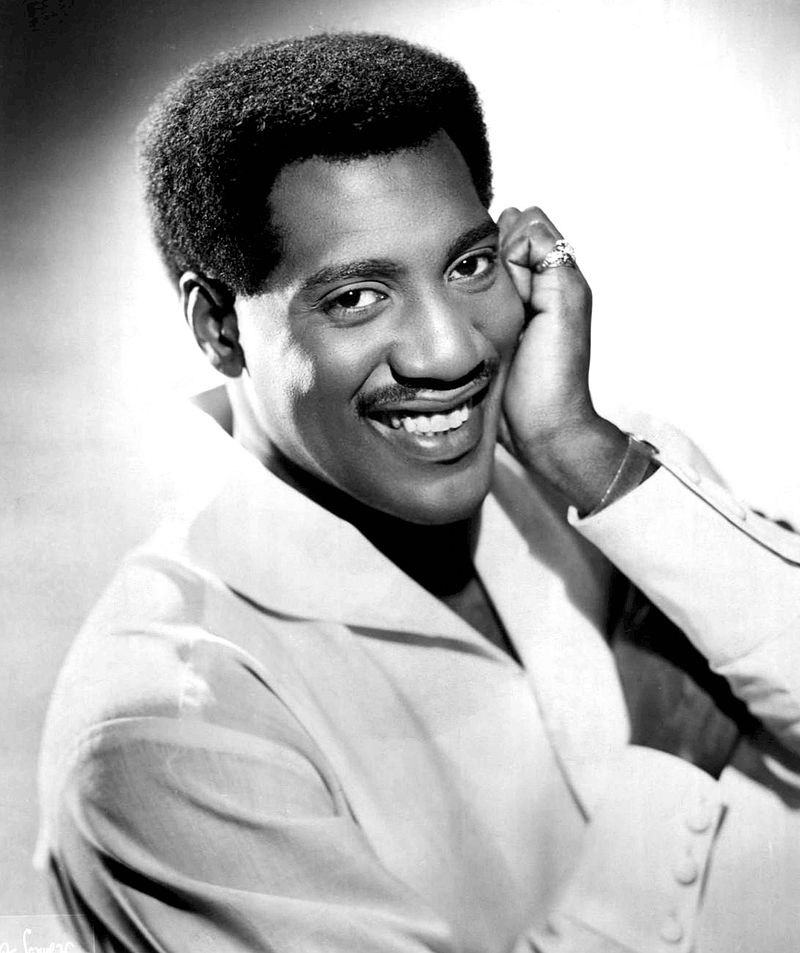Otis Redding
Otis Redding
Redding was born in Dawson, Georgia, the fourth of six children, and the first son of Otis Redding Sr. and Fannie Roseman. Redding Sr. was a sharecropper and then worked at Robins Air Force Base, near Macon, and occasionally preached in local churches. When Redding was three, the family moved to Tindall Heights, a predominantly African-American public housing project in Macon. At an early age, he sang in the Vineville Baptist Church choir and learned guitar and piano. From age 10, Redding took drum and singing lessons. At Ballard-Hudson High School, he sang in the school band. Every Sunday he earned $6 by performing gospel songs for Macon radio station WIBB, and he won the $5 prize in a teen talent show for 15 consecutive weeks. His passion was singing, and he often cited Little Richard and Sam Cooke as influences. Redding said that he "would not be here" without Little Richard and that he "entered the music business because of Richard – he is my inspiration. I used to sing like Little Richard, his rock 'n' roll stuff ... My present music has a lot of him in it."
At age 15, Redding left school to help financially support his family; his father had contracted tuberculosis and was often hospitalized, leaving his mother as the family's primary income earner. He worked as a well digger, as a gasoline station attendant, and occasionally as a musician. Pianist Gladys Williams, a locally well-known musician in Macon and another who inspired Redding, often performed at the Hillview Springs Social Club, and Redding sometimes played piano with her band there. Williams hosted Sunday talent shows, which Redding attended with two friends, singers Little Willie Jones and Eddie Ross.
Redding's breakthrough came in 1958 on disc jockey Hamp Swain's "The Teenage Party", a talent contest at the local Roxy and Douglass Theatres. Johnny Jenkins, a locally prominent guitarist, was in the audience and, finding Redding's backing band lacking in musical skills, offered to accompany him. Redding sang Little Richard's "Heebie Jeebies". The combination enabled Redding to win Swain's talent contest for fifteen consecutive weeks; the cash prize was $5 (US$51 in 2022 dollars). Jenkins later worked as lead guitarist and played with Redding during several later gigs. Redding was soon invited to replace Willie Jones as frontman of Pat T. Cake and the Mighty Panthers, featuring Johnny Jenkins. Redding was then hired by the Upsetters when Little Richard abandoned rock and roll in favor of gospel music. Redding was well paid, making about $25 per gig (US$254 in 2022 dollars), but did not stay long. In mid-1960, Otis moved to Los Angeles with his sister, Deborah, while his wife Zelma and their children stayed in Macon, Georgia. In Los Angeles Redding recorded his first songs, including "Tuff Enuff" written by James McEachin, "She's All Right", written with McEachin, and two Redding wrote alone, called "I'm Gettin' Hip" and "Gamma Lamma" (which he recorded as a single in 1961, under the title "Shout Bamalama").
Career
A member of Pat T. Cake and the Mighty Panthers, Redding toured the Southern United States on the Chitlin' Circuit, a string of venues that were hospitable to African-American entertainers during the era of racial segregation, which lasted into the early 1960s. Johnny Jenkins left the band to become the featured artist with the Pinetoppers. Around this time, Redding met Phil Walden, the future founder of the recording company Phil Walden and Associates, and later Bobby Smith, who ran the small label Confederate Records. He signed with Confederate and recorded a single, "Shout Bamalama" (a rewrite of "Gamma Lamma") and "Fat Girl", together with his band Otis and the Shooters. Around this time he and the Pinetoppers attended a "Battle of the Bands" show in Lakeside Park. Wayne Cochran, the only solo artist signed to Confederate, became the Pinetoppers' bassist.
When Walden started to look for a record label for Jenkins, Atlantic Records representative Joe Galkin showed interest and around 1962 sent him to the Stax studio in Memphis. Redding drove Jenkins to the session, as the latter did not have a driver's license. The session with Jenkins, backed by Booker T. & the M.G.'s, was unproductive and ended early; Redding was allowed to perform two songs. The first was "Hey Hey Baby", which studio chief Jim Stewart thought sounded too much like Little Richard. The second was "These Arms of Mine", featuring Jenkins on guitar and Steve Cropper on piano. Stewart later praised Redding's performance, saying, "Everybody was fixin' to go home, but Joe Galkin insisted we give Otis a listen. There was something different about [the ballad]. He really poured his soul into it." Stewart signed Redding and released "These Arms of Mine", with "Hey Hey Baby" on the B-side. The single was released by Volt in October 1962 and charted in March the following year. It became one of his most successful songs, selling more than 800,000 copies.
"These Arms of Mine" and other songs from the 1962–1963 sessions were included on Redding's debut album, Pain in My Heart. "That's What My Heart Needs" and "Mary's Little Lamb" were recorded in June 1963. The latter is the only Redding track with both background singing and brass. It became his worst-selling single. The title track, recorded in September 1963, sparked copyright issues, as it sounded like Irma Thomas's "Ruler of My Heart". Despite this, Pain in My Heart was released on March 1964, with the single peaking at number 11 on the R&B chart, number 61 on the Billboard Hot 100, and the album at number 103 on the Billboard 200.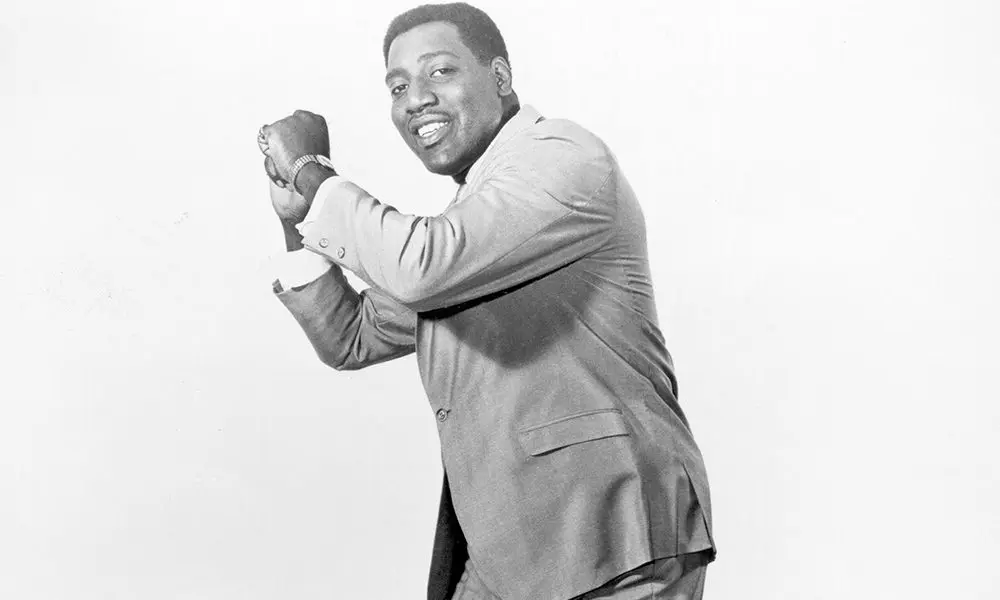
In November 1963, Redding, accompanied by his brother Rodgers and an associate, former boxer Sylvester Huckaby (a childhood friend of Redding's), traveled to New York to perform at the Apollo Theater for the recording of a live album for Atlantic Records. Redding and his band were paid $400 per week (US$3,823 in 2022 dollars) but had to pay $450 (US$4,301 in 2022 dollars) for sheet music for the house band, led by King Curtis, which left them in financial difficulty. The trio asked Walden for money. Huckaby's description of their circumstances living in the "big old raggedy" Hotel Theresa is quoted by Peter Guralnick in his book Sweet Soul Music. He noted meeting Muhammad Ali and other celebrities. Ben E. King, who was the headliner at the Apollo when Redding performed there, gave him $100 (US$956 in 2022 dollars) when he learned about Redding's financial situation. The resulting album featured King, the Coasters, Doris Troy, Rufus Thomas, the Falcons and Redding. Around this time Walden and Rodgers were drafted by the army; Walden's younger brother Alan joined Redding on tour, while Earl "Speedo" Simms replaced Rodgers as Redding's road manager.
Most of Redding's songs after "Security", from his first album, had a slow tempo. Disc jockey A. C. Moohah Williams accordingly labeled him "Mr. Pitiful", and subsequently, Cropper and Redding wrote the eponymous song. That and top 100 singles " Chained and Bound", "Come to Me" and "That's How Strong My Love Is" were included on Redding's second studio album, The Great Otis Redding Sings Soul Ballads, released in March 1965. Jenkins began working independently from the group out of fear Galkin, Walden and Cropper would plagiarize his playing style, and so Cropper became Redding's leading guitarist. Around 1965, Redding co-wrote "I've Been Loving You Too Long" with Jerry Butler, the former lead singer of the Impressions. That summer, Redding and the studio crew arranged new songs for his next album. Ten of the eleven songs were recorded in a 24-hour period on July 9 and 10 in Memphis. Two songs, "Ole Man Trouble" and "Respect", had been finished earlier, during the Otis Blue session. "Respect" and "I've Been Loving You" were later recut in stereo. The album, entitled Otis Blue: Otis Redding Sings Soul, was released in September 1965. Otis Blue also includes Redding's much-loved cover of "A Change Is Gonna Come" in 1965.
Redding's success allowed him to buy a 300-acre (1.2 km2) ranch in Georgia, which he called the "Big O Ranch". Stax was also doing well. Walden signed more musicians, including Percy Sledge, Johnnie Taylor, Clarence Carter and Eddie Floyd, and together with Redding, they founded two production companies. "Jotis Records" (derived from Joe Galkin and Otis) released four recordings, two by Arthur Conley and one by Billy Young and Loretta Williams. The other was named Redwal Music (derived from Redding and Walden), which was shut down shortly after its creation. Since Afro-Americans still formed the majority of fans, Redding chose to perform at Whisky a Go Go on the Sunset Strip in Los Angeles. Redding was one of the first soul artists to perform for rock audiences in the western United States. His performance received critical acclaim, including positive press in the Los Angeles Times, and he penetrated mainstream popular culture. Bob Dylan attended the performance and offered Redding an altered version of one of his songs, "Just Like a Woman".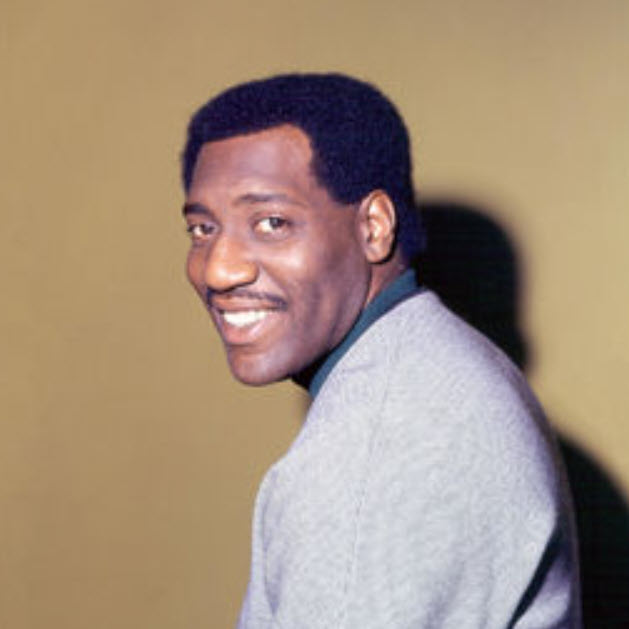
In late 1966, Redding returned to the Stax studio and recorded several tracks, including "Try a Little Tenderness", written by Jimmy Campbell, Reg Connelly and Harry M. Woods in 1932. This song had previously been recorded by Bing Crosby and Frank Sinatra, and the publishers unsuccessfully tried to stop Redding from recording the song from a "negro perspective". Today often considered his signature song, Jim Stewart reckoned, "If there's one song, one performance that really sort of sums up Otis and what he's about, it's 'Try a Little Tenderness'. That one performance is so special and so unique that it expresses who he is." On this version Redding was backed by Booker T. & the M.G.'s, while staff producer Isaac Hayes worked on the arrangement. "Try a Little Tenderness" was included on his next album, Complete & Unbelievable: The Otis Redding Dictionary of Soul. The song and the album were critically and commercially successful—the former peaked at number 25 on the Billboard Hot 100 chart and at number 4 on the R&B chart.
The spring of 1966 marked the first time that Stax booked concerts for its artists. The majority of the group arrived in London on March 13, but Redding had flown in days earlier for interviews, such as at "The Eamonn Andrews Show". When the crew arrived in London, the Beatles sent a limousine to pick them up. Booking agent Bill Graham proposed that Redding play at the Fillmore Auditorium in late 1966. The gig was commercially and critically successful, paying Redding around $800 to $1000 (US$9,019 in 2022 dollars) a night. It prompted Graham to remark afterward, "That was the best gig I ever put on in my entire life." Redding began touring Europe six months later.
In March 1967, Stax released King & Queen, an album of duets between Redding and Carla Thomas, which became a certified gold record. It was Jim Stewart's idea to produce a duet album, as he expected that "[Redding's] rawness and [Thomas's] sophistication would work". The album was recorded in January 1967, while Thomas was earning her M.A. in English at Howard University. Six out of ten songs were cut during their joint session; the rest were overdubbed by Redding in the days following, because of his concert obligations. Three singles were lifted from the album: "Tramp" was released in April, followed by "Knock on Wood" and "Lovey Dovey". All three reached at least the top 60 on both the R&B and Pop charts. The album charted at number 5 and 36 on the Billboard Pop and R&B charts, respectively.
Redding returned to Europe to perform at the Paris Olympia. The live album Otis Redding: Live in Europe was released three months later, featuring this and other live performances in London and Stockholm, Sweden. His decision to take his protege Conley (whom Redding and Walden had contracted directly to Atco/Atlantic Records rather than to Stax/Volt) on the tour, instead of more established Stax/Volt artists such as Rufus Thomas and William Bell, produced negative reactions.
In 1967, Redding performed at the influential Monterey Pop Festival as the closing act on Saturday night, the second day of the festival. He was invited through the efforts of promoter Jerry Wexler. Until that point, Redding was still performing mainly for black audiences. At the time, he "had not been considered a commercially viable player in the mainstream white American market."But after delivering one of the most electric performances of the night, and having been the act to most involve the audience, "his performance at Monterey Pop was therefore a natural progression from local to national acclaim,...the decisive turning-point in Otis Redding's career." His act included his own song "Respect" and a version of the Rolling Stones' "Satisfaction". Redding and his backing band (Booker T. & the M.G.'s with the Mar-Keys horn section) opened with Cooke's "Shake", after which he delivered an impromptu speech, asking the audience if they were the "love crowd" and looking for a big response. The ballad "I've Been Loving You" followed. The last song was "Try a Little Tenderness", including an additional chorus. "I got to go, y'all, I don't wanna go", said Redding and left the stage of his last major concert. According to Booker T. Jones, "I think we did one of our best shows, Otis and the MG's. That we were included in that was also something of a phenomenon. That we were there? With those people? They were accepting us and that was one of the things that really moved Otis. He was happy to be included and it brought him a new audience. It was greatly expanded in Monterey." According to Sweet Soul Music, musicians such as Brian Jones and Jimi Hendrix were captivated by his performance; Robert Christgau wrote in Esquire, "The Love Crowd screamed one's mind to the heavens."
Before Monterey, Redding wanted to record with Conley, but Stax was against the idea. The two moved from Memphis to Macon to continue writing. The result was "Sweet Soul Music" (based on Cooke's "Yeah Man"), which peaked at number 2 on the Billboard Hot 100. By that time, Redding had developed polyps on his larynx, which he tried to treat with tea and lemon or honey. He was hospitalized in September 1967 at Mount Sinai Hospital in New York to undergo surgery.
In early December 1967, Redding again recorded at Stax. One new song was "(Sittin' On) The Dock of the Bay", which was written with Cropper. Redding was inspired by the Beatles album Sgt. Pepper's Lonely Hearts Club Band and tried to create a similar sound, against the label's wishes. His wife Zelma disliked its atypical melody. The Stax crew were also dissatisfied with the new sound; Stewart thought that it was not R&B, while bassist Donald "Duck" Dunn feared it would damage Stax's reputation. However, Redding wanted to expand his musical style and thought it was his best song, correctly believing it would top the charts. He whistled at the end, either forgetting Cropper's "fadeout rap" or paraphrasing it intentionally.
Death
By 1967, the band was traveling to performances in Redding's Beechcraft H18 airplane. On December 9, they appeared on the Upbeat television show produced in Cleveland. They played three concerts in two nights at a club called Leo's Casino. After a phone call with his wife and children, Redding's next stop was Madison, Wisconsin; the next day, Sunday, December 10, they were to play at the Factory nightclub, near the University of Wisconsin.
Although the weather was poor, with heavy rain and fog, and despite warnings, the plane took off. Four miles (6.5 km) from their destination at Truax Field in Madison, pilot Richard Fraser radioed for permission to land. Shortly thereafter, the plane crashed into Lake Monona. Bar-Kays member Ben Cauley, the accident's only survivor, was sleeping shortly before the accident. He woke just before impact to see bandmate Phalon Jones look out a window and exclaim, "Oh, no!" Cauley said the last thing he remembered before the crash was unbuckling his seat belt. He then found himself in frigid water, grasping a seat cushion to keep afloat. As a non-swimmer, he was unable to rescue the others. The cause of the crash was never determined. Besides Redding, the other victims of the crash were four members of the Bar-Kays—guitarist Jimmy King, tenor saxophonist Phalon Jones, organist Ronnie Caldwell, and drummer Carl Cunningham; their valet, Matthew Kelly; and the pilot Fraser.
Redding's body was recovered the next day when the lake was searched. The family postponed the funeral from December 15, to December 18, so that more could attend, and the service took place at the City Auditorium in Macon. More than 4,500 people came to the funeral, overflowing the 3,000-seat hall. Redding was entombed at his ranch in Round Oak, about twenty miles (30 km) north of Macon. Jerry Wexler delivered the eulogy. Redding died just three days after re-recording "(Sittin' On) The Dock of the Bay", and was survived by Zelma and four children, Otis III, Dexter, Demetria, and Karla. August 1997, a memorial plaque was placed on the lakeside deck of the Madison convention center, Monona Terrace.
Style
Early on Redding copied the rock and soul style of his role model Little Richard. He was also influenced by soul musicians such as Sam Cooke, whose live album Sam Cooke at the Copa was a strong influence, but later explored other popular genres. He studied the recordings of the Beatles and Bob Dylan. His song "Hard to Handle" has elements of rock and roll and influences of Eric Clapton and Jimi Hendrix. Most of his songs were categorized as Southern soul and Memphis soul.
His hallmark was his raw voice and ability to convey strong emotion. Richie Unterberger of Allmusic noted his "hoarse, gritty vocals, brassy arrangements, an emotional way with both party tunes and aching ballads." In the book Rock and Roll: An Introduction, authors Michael Campbell and James Brody suggested that "Redding's singing calls to mind a fervent black preacher. Especially in up-tempo numbers, his singing is more than impassioned speech but less than singing with precise pitch." According to the book, "Redding finds a rough midpoint between impassioned oratory and conventional singing. His delivery overflows with emotion" in his song "I Can't Turn You Loose". Booker T. Jones described Redding's singing as energetic and emotional but said that his vocal range was limited, reaching neither low nor high notes. Peter Buckley, in The Rough Guide to Rock, describes his "gruff voice, which combined Sam Cooke's phrasing with a brawnier delivery" and later suggested he "could testify like a hell-bent preacher, croon like a tender lover or get down and dirty with a bluesy yawp".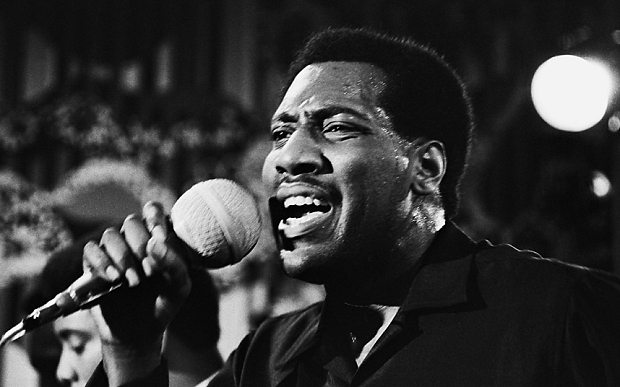
Redding received advice from Rufus Thomas about his clumsy stage appearance. Jerry Wexler said Redding "didn't know how to move", and stood still, moving only his upper body, although he acknowledged that Redding was well received by audiences for his strong message. Guralnick described Redding's painful vulnerability in Sweet Soul Music, as an attractive one for the audience, but not for his friends and partners. His early shyness was well known.
Songwriting
In his early career Redding mostly covered songs from popular artists, such as Richard, Cooke and Solomon Burke. Around the mid-1960s he began writing his own songs—always taking along his cheap red acoustic guitar—and sometimes asked for Stax members' opinion of his lyrics. He often worked on lyrics with other musicians, such as Simms, Rodgers, Huckaby, Phil Walden, and Cropper. During his recovery from his throat operation, Redding wrote about 30 songs in two weeks. Redding was the sole copyright holder on all of his songs.
In "(Sittin' On) The Dock of the Bay" he abandoned familiar romantic themes for "sad, wistful introspections, amplified by unforgettable descending guitar riffs by Cropper". The website of the Songwriters Hall of Fame noted that the song "was a kind of brooding, dark voicing of despair, ('I've got nothin' to live for/Look like nothin's gonna come my way')" although "his music, in general, was exultant and joyful." According to journalist Ruth Robinson, author of the liner notes for the 1993 box set, "It is currently a revisionist theory to equate soul with the darker side of man's musical expression, blues. That fanner of the flame of 'Trouble's got a hold on me' music, might well be the father of the form if it is, the glorified exaltation found in church on any Sunday morning is its mother." The Songwriters Hall of Fame website adds that "glorified exaltation indeed was an apt description of Otis Redding's songwriting and singing style." Booker T. Jones compared Redding with Leonard Bernstein, stating, "He was the same type person. He was a leader. He'd just lead with his arms and his body and his fingers."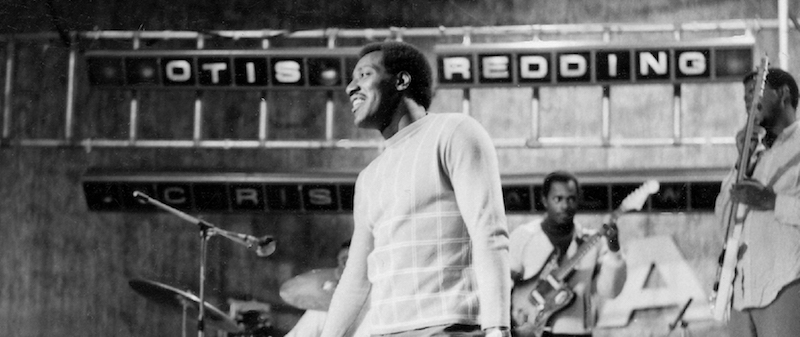
Redding favored short and simple lyrics; when asked whether he intended to cover Dylan's "Just Like a Woman", he responded that the lyrics contained "too much text". Furthermore, he stated in an interview,
Basically, I like any music that remains simple and I feel this is the formula that makes "soul music" successful. When any music form becomes cluttered and/or complicated you lose the average listener's ear. There is nothing more beautiful than a simple blues tune. There is beauty in simplicity whether you are talking about architecture, art or music.
Redding also authored his (sometimes difficult) recordings' horn arrangements, humming to show the players what he had in mind. The recording of "Fa-Fa-Fa-Fa-Fa (Sad Song)" captures his habit of humming with the horn section.
References
- Labrie 1968, p. 38.
- ^ Phelps 1997, p. 179.
- ^ Otis Redding Southern Soul June 27, 2022
- ^ "Black Music & Entertainment Walk of Fame Announced With First Three Inductees". Billboard. February 18, 2021. Retrieved April 15, 2021. Jump up to
- a b c Guralnick 1999, pp. 164–167. Jump up to
- a b c d Bowman 1997, p. 40. Jump up to
- a b Brown 2001, p. 10.
- ^ Wall Street Journal; "Singing You Out of Your Shoes"; Dean, Eddie; May 27, 2017

